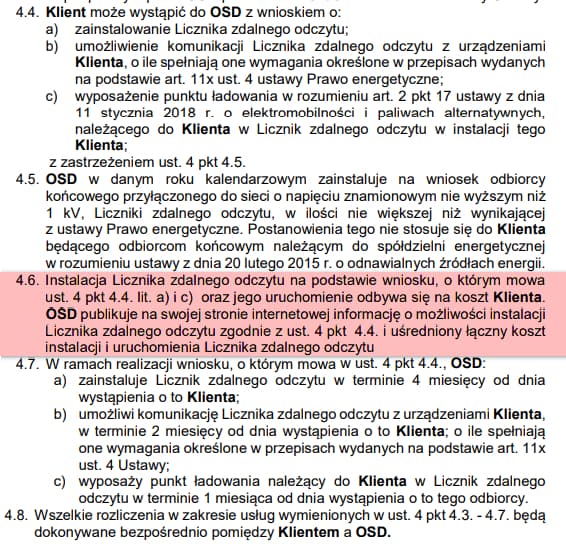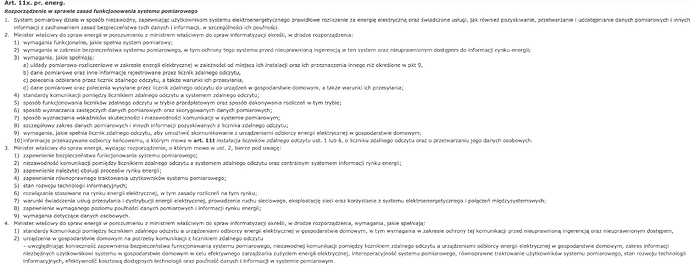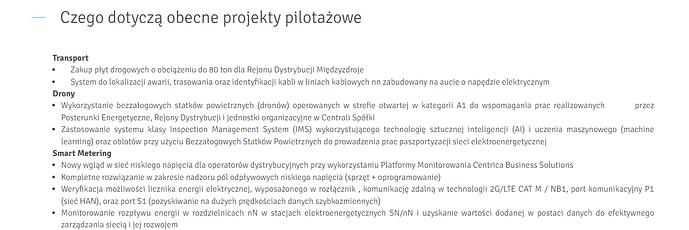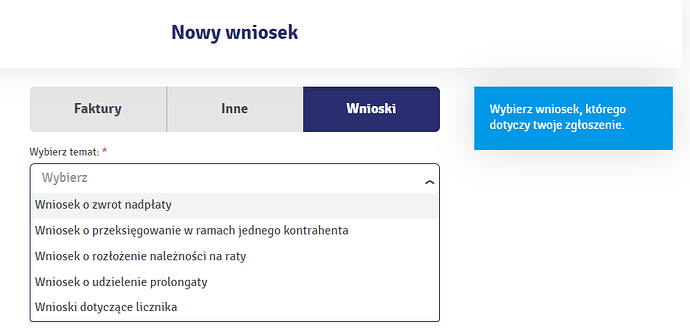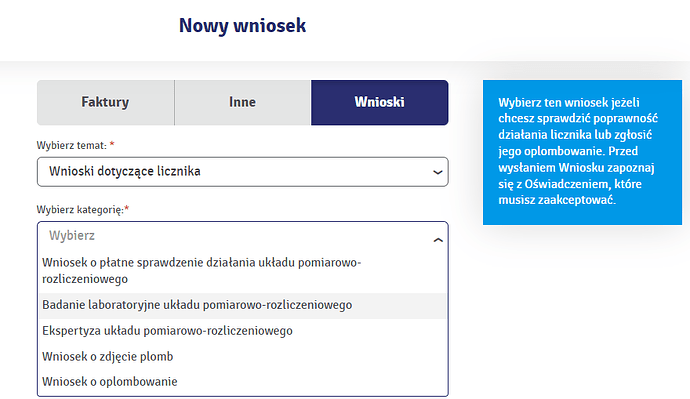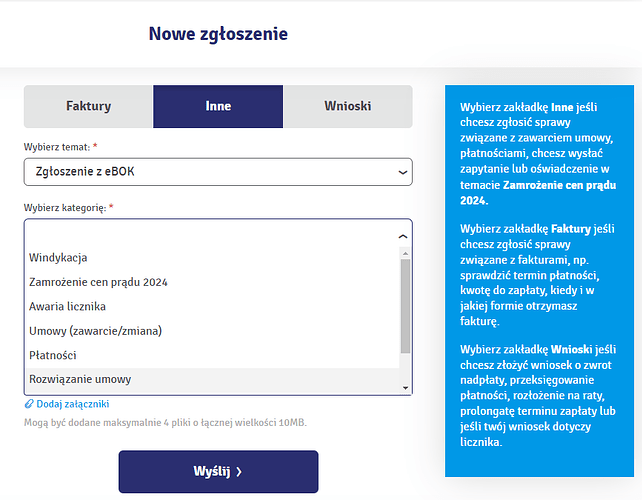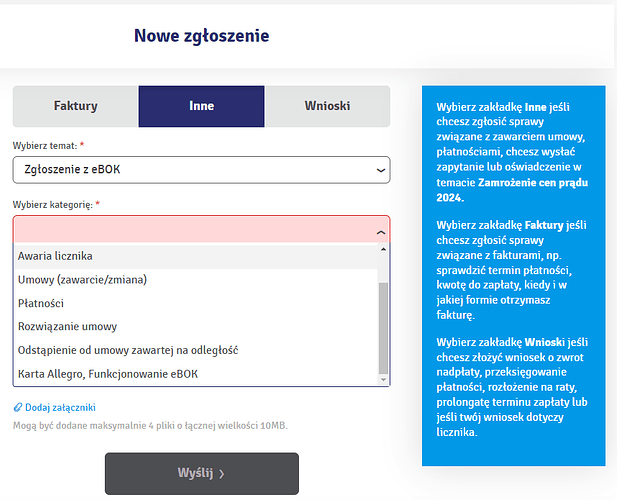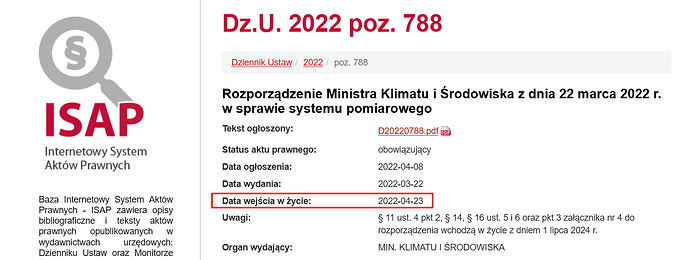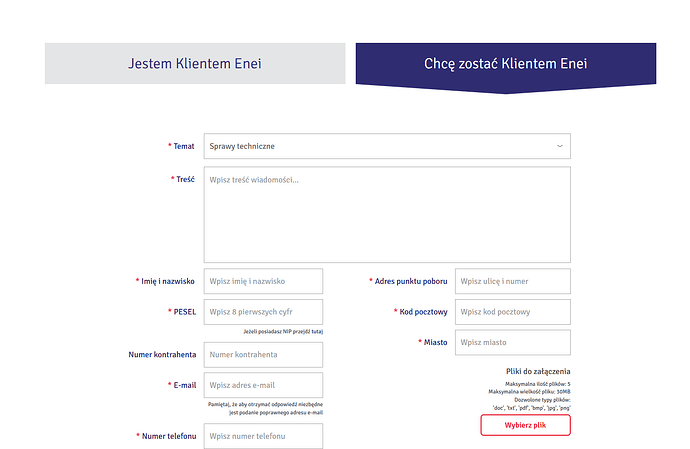Jeszcze nie ale daj dzień albo dwa to coś podeślę.
Mam pytanie bo widzę, że masz w tym doświadczenie. Czy w przyszłości wszystkie liczniki elektryczne maja nadawać sygnał wM-Bus? Bo sam posiadam ISKRE AM550 i tam jest tylko po szynie i złącze P1 po RJ-12. A sąsiad ma OTUS 3 od Apatora i próbuje to dla niego zrobić. A OTUS wiem że ma komunikację po wM-Bus. Jeżeli tak to powinni u mnie też w przyszłości wymienić. Jest nawet Rozporządzenia Ministra Klimatu i Środowiska z dnia 22 marca 2022 r, które o tym mówi.
Nie mam pojęcia czy tak będzie.
Niestety Licznik prądu APATOR OTUS 3 od Enea Operator milczy. Nie nadaje nic. Złapałem za to całą ulicę liczników wody APATOR16-2. Klops jak na dzisiaj.
First of all, please excuse me for replying in English, but I do not speak Polish, unfortunately. And I think it is better if I write in English, than trying to translate it with Google translate without knowing the result is good or not.
This might be a bit off-topic, but I am looking for some solution for an ENEA deployed OTUS 3 as well.
I would like to ask, if you have managed to get ENEA to activate the W-MBUS on the OTUS 3. Or maybe got P1 port activated on the AM550? Their term of services is adapted to the current Energy law and has a section about, that you can apply for the local communication with the meter, but they don’t have any form to do so, or I have not found it yet.
4.4. Klient może wystąpić do OSD z wnioskiem o:
a) zainstalowanie Licznika zdalnego odczytu;
b) umożliwienie komunikacji Licznika zdalnego odczytu z urządzeniami
Klienta, o ile spełniają one wymagania określone w przepisach wydanych
na podstawie art. 11x ust. 4 ustawy Prawo energetyczne;
c) wyposażenie punktu ładowania w rozumieniu art. 2 pkt 17 ustawy z dnia
11 stycznia 2018 r. o elektromobilności i paliwach alternatywnych,
należącego do Klienta w Licznik zdalnego odczytu w instalacji tego
Klienta;
z zastrzeżeniem ust. 4 pkt 4.5.
In theory yes, maybe by 2033, or whatever the deadline for the whole smart metering changes. The art. 11x ust. 4 ustawy Prawo energetyczne, has a reference to another regulation which is the something called “Law of measurement”, I don’t remember exactly, that states that all smart electricity meters should have W-MBUS communication, but there can be exemptions in some cases, I guess the P1 port would be sufficient as well. But knowing how operators work, and how they blocked access to the IR port on these meters for OneMeter, I don’t expect too much.
You can actually access the hourly consumption data on the EBOK, but it is lagging 2 or 3 days behind.
I am in a similar situation as you, I used to have an Iskra M174, which worked perfectly with OneMeter. I dodged a few times to have replacement either to the Iskra AM550 or the APATOR OTUS3, but last October a serviceman turned up on a late Friday afternoon, and without ringing the bell or anything, just replaced it, you can imagine how my wife was surprised when the power just went off in the house, and turned out that the guy was working on the meter.
I was absolutely against the smart meter, because I read all the stories how you cannot access your data on it, and what nobody advertises, all of these meters are equiped according the requirements a remote disconnector as well, which means the operator can shut off your power remotely without you letting know anything.
The law actually states that the DSO should provide information about the smart meter’s capapbilities before or during the installation, guess what, it has not happened since.
So, I have an OTUS3, the neighbour have an AM550. I just hope that the OTUS3 will not have a meltdown during the summer, as I heard some stories about their temperature handling capabilities as well. In the cabinet during last summer the temperature was about 60 Celsius, as the OneMeter device was reporting that.
To be honest, I envy all the Tauron clients from the Wroclaw area where you have website to enable the W-MBUS on the AMI meter. That’s just a revelation compared to some other operators.
Niestety koszty przerzucane są na odbiorcę. Jak chcesz mieć możliwość dostępu do danych zużycia i produkcji energii elektrycznej wcześniej niż 2031 to płać i płacz.
I think, that you have not read it correctly.
4.6. Instalacja Licznika zdalnego odczytu na podstawie wniosku, o którym mowa
ust. 4 pkt 4.4. lit. a) i c) oraz jego uruchomienie odbywa się na koszt Klienta.
OSD publikuje na swojej stronie internetowej informację o możliwości instalacji
Licznika zdalnego odczytu zgodnie z ust. 4 pkt 4.4. i uśredniony łączny koszt
instalacji i uruchomienia Licznika zdalnego odczytu
4.4. Klient może wystąpić do OSD z wnioskiem o:
a) zainstalowanie Licznika zdalnego odczytu;
b) umożliwienie komunikacji Licznika zdalnego odczytu z urządzeniami
Klienta, o ile spełniają one wymagania określone w przepisach wydanych
na podstawie art. 11x ust. 4 ustawy Prawo energetyczne;
c) wyposażenie punktu ładowania w rozumieniu art. 2 pkt 17 ustawy z dnia
11 stycznia 2018 r. o elektromobilności i paliwach alternatywnych,
należącego do Klienta w Licznik zdalnego odczytu w instalacji tego
Klienta;
z zastrzeżeniem ust. 4 pkt 4.5
I am following these changes for a while. It used to include b) as well. But the last change of the Prawo energetyczne removed that.
ENEA do have prices for Smart meter installation or rental of a meter. The reason of the whole smart metering regulation comes from a EU directive, which purpose is generally transparency on electricity use. If you need, I can link the EU directive and the Polish laws, regulations as well.
177 / 5 000
Wyniki tłumaczenia
Tłumaczenie
You’re right. My mistake. This means that you can submit an application to enable the remote reading meter to communicate with customer devices. Under the condition
Masz rację. Moje niedopatrzenie. To znaczy, że można złożyć wniosek o uruchomienie umożliwienie komunikacji licznika zdalnego odczytu z urządzeniami klienta. Pod warunkiem.
https://isap.sejm.gov.pl/isap.nsf/download.xsp/WDU20220000788/O/D20220788.pdf

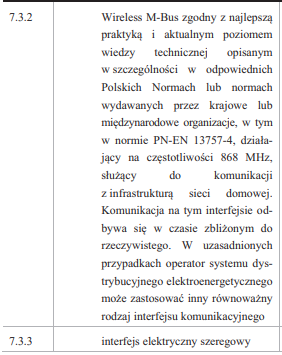
You just need to find out what the application should look like and submit it.
This is too good to be true.
Tylko należy dowiedzieć się jak powinien wyglądać wniosek i go złożyć.
To jest za piękna aby było prawdziwe.
Muszę niestety sprostować moją poprzednią wypowiedz
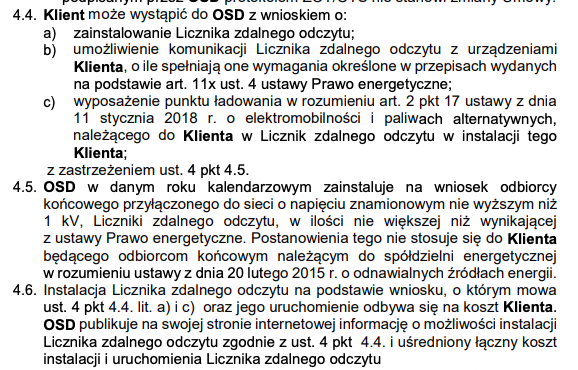
Z regulaminy wynika iż tylko umożliwienie klientowi komunikacji Licznika zdalnego odczytu z urządzeniami Klienta jest nieodpłatne. Niestety ich instalacja na wniosek jest już odpłatna. Aby nie płacić za wymianę możemy poczekać albo musimy do 2031.
You just need to try to contact ENEA to activate it. They should do it free of charge. The payment is for the smart meter, if you don’t have one, but you have already an AM550 and your neighbour an OTUS 3.
Worst case you will receive an answer like this:
w odpowiedzi na ponowną reklamację dotyczącą zainstalowania Licznika Zdalnego Odczytu (LZO), ponownie informujemy, iż w związku z faktem, że liczniki jakimi obecnie dysponuje ENEA Operator Sp. z o.o. zostały wyprodukowane i zakupione przed opublikowaniem przez ustawodawcę szczegółowych wytycznych dotyczących funkcjonalności dla LZO, zawartych w rozporządzeniu Ministra Klimatu i Środowiska z dnia 22 marca 2022r. w sprawie systemu pomiarowego, liczniki te zgodnie z zapisami Rozporządzenia mogą nie realizować w chwili obecnej wszystkich funkcjonalności wskazanych w rozporządzeniu. Wobec powyższego wymagania przedstawione przez Panią dotyczące komunikacji dla Użytkownika końcowego nie znajdują odzwierciedlenia w przedmiotowej sytuacji.
Zgodnie z przepisami Rozporządzenia Ministra Klimatu i Środowiska z dnia 22 marca 2022r. (Dz.U Poz. 788) liczniki zainstalowane w okresie od 4 lipca 2019 r. do dnia wejścia w życie rozporządzenia oraz zainstalowane po dniu wejścia w życie Rozporządzenia, ale zakupione w wyniku wszczęcia procedury przetargowej przed dniem wejścia w życie przepisów będą dostosowywane do dnia 4 lipca 2031r.
Dodatkowo informujemy, że w najbliższym czasie planowane jest przez ENEA Operator Sp. z o.o. uruchomienie portalu, w którym udostępnianie będą dane pomiarowe. Informacja o uruchomieniu portalu zostanie przedstawiona na stronie internetowej Enea Operator.
This is all bollocks to be honest. This answer was about a year ago, when I managed to get my wife to complain about the replacement to smart meter. She just do not want to deal with it, and I cannot communicate with them, because they do not speak English.
You can send them an email, that you request according to their TOS to active the local communication of the device and provide the address and encryption key.
The joke in the story, ENEA Operator brags about innovation…
https://www.operator.enea.pl/ospolce/innowacje-w-enei-operator
But really they just waste the money on these things. How on Earth a remote reading meter is not processed almost real time? EBOK provides data 2-3 days behind. The amount of data transmitted is minimal. Processing of that should take seconds only. But it is still days behind.
The meters (OTUS 3) are built in Poland, there is no language barrier to understand the working structure of it. A couple of DIYers would sort out the whole problem in less than a month, but no interest from the DSOs. They like to keep you in the dark regarding what you are consuming.
All the operational meters have been purchased or tendered before the aforementioned deadlines.
Niestety dostałem taką samą odpowiedz w lutym. U mnie jest gorzej bo mam licznik ISKRA550, który jest Licznikiem zdalnego odczytu, ale zakupiony i założona przed 2022 r. Nie mam możliwości uruchomienia komunikacji dla Użytkownika końcowego w czasie rzeczywistym.
Unfortunately, I got the same answer in February. It’s worse for me because I have an ISKRA550 meter, which is a remote reading meter, but purchased and installed before 2022. I am not able to start communication for the end user in real time.
That is really a shame. Only a blanket answer just to divert people. I am thinking of to contact a governing party politician and bring it to their attention.
I used to use OneMeter which communicates through the IR port. Unfortunately it has became a paper weight as these new remote reading meters are encrypted. As that is one of the requirements that the law dictates. They use DLMS/COSEM which is an overcomplicated protocol with multilevel permissions etc. The DSOs do not provide neither username or encryption/decryption key.
This whole smart metering set back everything about 30 years. One of the electricians told me that I can read the meter from the LCD by pressing the buttons on it. In the city I have a OTUS 3, but I know a place which still has one of the rotary type meters. This is the 3rd meter which I have in the past 2.5 years. Originally an Iskra MT174, then another MT174, both of them was working correctly, had no problems, but the first had to be changed due to a PV installation. The second had to be changed, because it wasn’t a remote reading meter. A waste of money and resources. And as a result, I cannot read the meter.
And as you can read from the communication, after almost a year, there is no website to get the meter readings.
Just as a comparison, in Switzerland, a user received a meter from his DSO just to test on it.
Otus 3 meters have wmbus, and can be read by esphome wm bus component but you have to ask PGE or ENEA to turn on wmbus and send you the key. I think in Enea you can do this online.
If you could tell how and where, that would be great. And yes, that is the reason why I am here, to get the WMBUS with ESPHome. ![]()
I think you have to use enea operator ebok to send a request. My operator is PGE and I had to fill out a form and mail it. You can always email them and ask how to do this.
https://isap.sejm.gov.pl/isap.nsf/DocDetails.xsp?id=WDU20220000788
This is the key date referred to in ENEA’s responses.
To be honest, the EBOK is completely FUBAR.
The images are from the ENEA’s EBOK, and not ENEA Operator’s EBOK, because I cannot register there. The contract is with ENEA. Cumbersome? Yes, indeed, as much as it can be.
The meter and the number of the meter is not listed anywhere, but then I can see the remote reading meter’s daily, monthly, yearly before and after balancing under the Dane dobowo-godzinowe, but the Historia odczytów and Historia zużycia contains only data before the PV contract.
Have you read that? Because I did.
They always try to blanket cover with this:
§ 21.
Przepisy rozporządzenia stosuje się do układów pomiarowo-rozliczeniowych instalowanych lub modernizowanych po dniu wejścia w życie rozporządzenia.
Układy pomiarowo-rozliczeniowe:
zainstalowane lub zmodernizowane w okresie od dnia 4 lipca 2019 r. do dnia wejścia w życie rozporządzenia oraz
instalowane po dniu wejścia w życie rozporządzenia, które zostały zakupione lub były objęte postępowaniem przetargowym wszczętym przed tym dniem
- dostosowuje się do wymagań określonych w rozporządzeniu w terminie do dnia 4 lipca 2031 r.
But this is there as well:
§ 22.
Rozporządzenie wchodzi w życie po upływie 14 dni od dnia ogłoszenia, z wyjątkiem § 11 ust. 4 pkt 2, § 14, § 16 ust. 5 i 6 oraz pkt 3 załącznika nr 4 do rozporządzenia, które wchodzą w życie z dniem 1 lipca 2024 r.
And this:
Informacje przekazywane odbiorcy końcowemu o liczniku zdalnego odczytu oraz o przetwarzaniu danych osobowych tego odbiorcy
§ 19.
Operator systemu elektroenergetycznego lub właściciel urządzeń, instalacji lub sieci, w przypadku gdy użytkownik systemu jest przyłączony do urządzeń, instalacji lub sieci, na których nie wyznaczono operatora systemu elektroenergetycznego, udostępnia odbiorcy końcowemu, u którego ma zostać lub został zainstalowany licznik zdalnego odczytu, informacje dotyczące:
sposobu komunikacji licznika zdalnego odczytu z urządzeniami odbiorcy końcowego;
funkcji licznika zdalnego odczytu oraz interoperacyjności charakteryzującej ten licznik;
usług, z jakich można korzystać za pomocą licznika zdalnego odczytu;
korzyści, jakie można osiągnąć dzięki posiadaniu licznika zdalnego odczytu;
przetwarzania danych osobowych tego odbiorcy w zakresie określonym w art. 13 rozporządzenia Parlamentu Europejskiego i Rady (UE) 2016/679 z dnia 27 kwietnia 2016 r. w sprawie ochrony osób fizycznych w związku z przetwarzaniem danych osobowych i w sprawie swobodnego przepływu takich danych oraz uchylenia dyrektywy 95/46/WE (ogólne rozporządzenie o ochronie danych).
This is about generally the remote reading meter. And not the measurement and billing system (układów pomiarowo-rozliczeniowych). They even do not provide any information how the meter works and what it is capable of (remote disconnector).
The Energy Law states the followings as well:
- Odbiorca końcowy przyłączony do sieci o napięciu znamionowym nie wyższym niż 1 kV operatora systemu dystrybucyjnego elektroenergetycznego oraz odbiorca końcowy i wytwórca energii elektrycznej należący do spółdzielni energetycznej w rozumieniu art. 2 pkt 33a ustawy z dnia 20 lutego 2015 r. o odnawialnych źródłach energii mogą wystąpić z wnioskiem do tego operatora o:
- zainstalowanie licznika zdalnego odczytu;
- umożliwienie komunikacji licznika zdalnego odczytu z urządzeniami tego odbiorcy, o ile spełniają one wymagania określone w przepisach wydanych na podstawie art. 11x ust. 4;
- wyposażenie punktu ładowania w rozumieniu art. 2 pkt 17 ustawy z dnia 11 stycznia 2018 r. o elektromobilności i paliwach alternatywnych należącego do odbiorcy końcowego w licznik zdalnego odczytu w instalacji tego odbiorcy.
- Operator systemu dystrybucyjnego elektroenergetycznego:
- zainstaluje licznik zdalnego odczytu w terminie 4 miesięcy od dnia wystąpienia o to odbiorcy końcowego, o którym mowa w ust. 6;
- umożliwi komunikację licznika zdalnego odczytu z urządzeniami odbiorcy końcowego, o którym mowa w ust. 6, w terminie 2 miesięcy od dnia wystąpienia o to tego odbiorcy, o ile spełniają one wymagania określone w przepisach wydanych na podstawie art. 11x ust. 4;
- wyposaży punkt ładowania w rozumieniu art. 2 pkt 17 ustawy z dnia 11 stycznia 2018 r. o elektromobilności i paliwach alternatywnych należący do odbiorcy końcowego, o którym mowa w ust. 6, w licznik zdalnego odczytu w terminie miesiąca od dnia wystąpienia o to tego odbiorcy.
Operator systemu dystrybucyjnego elektroenergetycznego przekazuje odbiorcy końcowemu, o którym mowa w ust. 1 lub 6, podczas lub przed instalacją licznika zdalnego odczytu, informacje dotyczące tego licznika, określone w przepisach wydanych na podstawie art. 11x ust. 2, w tym informacje o:
funkcjach licznika zdalnego odczytu;
przetwarzaniu danych osobowych tego odbiorcy;
uśrednionych oraz długoterminowych kosztach i korzyściach związanych z taką instalacją;
pokryciu i uwzględnieniu kosztów określonych w ust. 4 oraz w art. 45 ust. 1i w kosztach działalności przedsiębiorstw energetycznych zajmujących się przesyłaniem lub dystrybucją energii elektrycznej, o których mowa w art. 45 ust. 1 pkt 1, i ujęciu ich w taryfie ogłaszanej w sposób określony w art. 47 ust. 3.
Its the same as with PGE, it’s just crap. In your case use this form:
https://www.enea.pl/formularz-dla-domu
If not then call them or go to their office, most of public owned companies have too much bureaucracy!
That’s why I envy the Tauron customers with AMI.

![]()
![]()
![]()
Or, I just need to wait the closure of this tender and the meters to arrive and get mine replaced before 2031…
If you have not realised, the smart metering is the holy milking cow… There are about a half dozen company which produces them, and they need to supply whole Europe with these meters according the EU directives. And all has to be anyhow replaced in every 8-10 years, or so…
Podstawa prawna:
Dyrektywa 2014/25/UE
